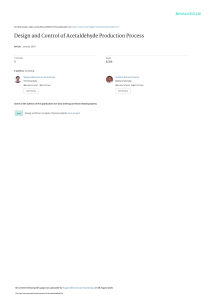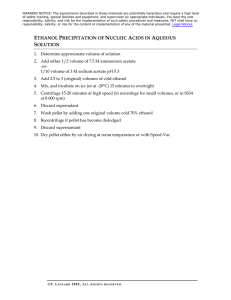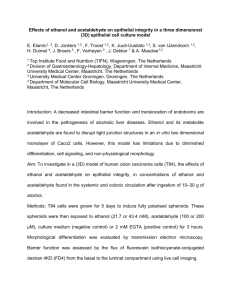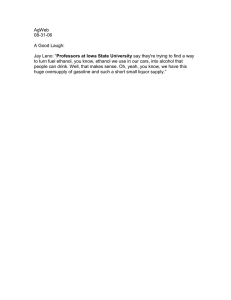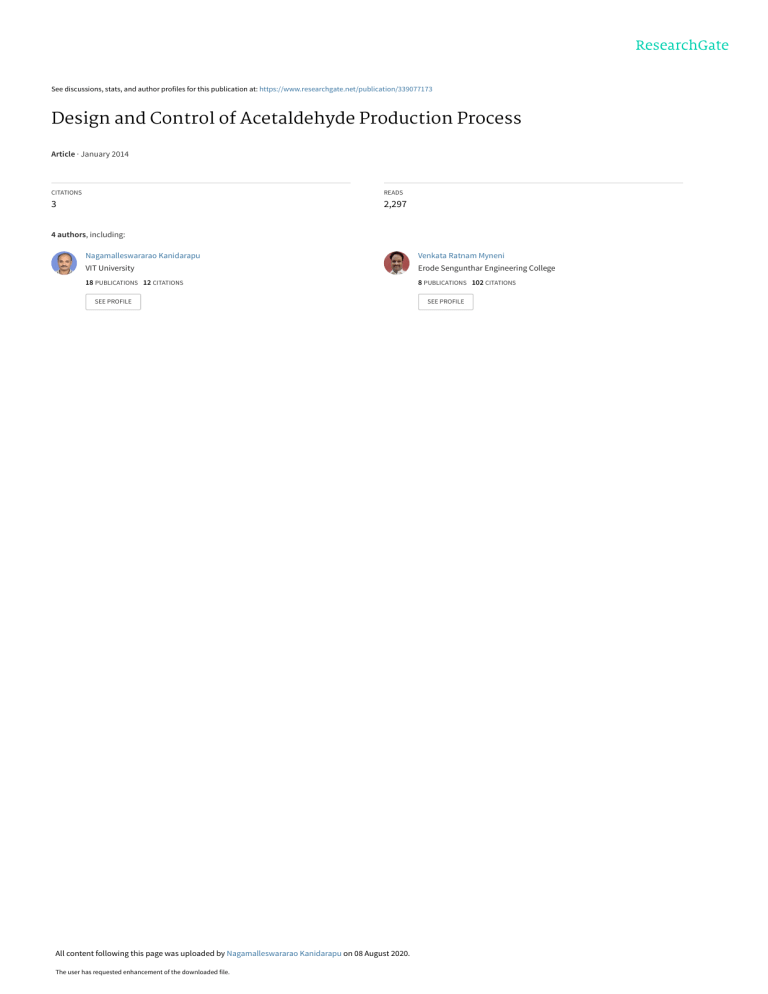
See discussions, stats, and author profiles for this publication at: https://www.researchgate.net/publication/339077173 Design and Control of Acetaldehyde Production Process Article · January 2014 CITATIONS READS 3 2,297 4 authors, including: Nagamalleswararao Kanidarapu Venkata Ratnam Myneni VIT University Erode Sengunthar Engineering College 18 PUBLICATIONS 12 CITATIONS 8 PUBLICATIONS 102 CITATIONS SEE PROFILE All content following this page was uploaded by Nagamalleswararao Kanidarapu on 08 August 2020. The user has requested enhancement of the downloaded file. SEE PROFILE Trends in Chemical Engineering Volume 1, Issue 1 www.stmjournals.com Design and Control of Acetaldehyde Production Process K. Nagamalleswara Rao1, M. Venkata Ratnam1, P. Rajendra Prasad2, V. Sujatha2 1 Department of Chemical Engineering, Bapatla Engineering College (Autonomous), Andhra Pradesh, India 2 Department of Chemical Engineering, AU College of Engineering, Andhra University, Vizag, India Abstract This paper discusses the steady state and dynamic simulations of acetaldehyde production process by using Aspen Plus and Aspen Dynamics. The model developed in the present study is the modification of the process developed by Eastman Chemical Company of U.S. Patent 6,121,498. The proposed design consists of a FEHE (feed effluent heat exchanger), reactor, absorption column, compressors and two distillation columns. Acetic acid reacts with hydrogen and gives acetaldehyde as main product and ethanol, ethyl acetate, acetone, and water as byproducts. The paper is divided into two stages. In the first stage, the entire process plant is developed for steady-state simulations and in the second stage, dynamic simulations are performed by providing decentralized controllers for the entire plant. Tray temperature control loop and composition control loop are designed to maintain final product purity. Results of dynamic simulation are analyzed for different process conditions. The proposed plant with control structure performs very well in rejecting various disturbances while maintaining the acetaldehyde product purity at 95.17 mol%, with a settling time of less than 9 h. Keywords: Apen Plus, U.S. Patent 6,121,498 Aspen Dynamics, temperature control loop, *Author for Correspondence E-mail: kanidarapunag2001@gmail.com INTRODUCTION Many efforts are being made to expand the manufacture of chemical products in such a way as to minimize pollution. The conceptual design of such production plants involves interplay between design and operational requirements, which attempts to balance noncommensurable objectives such as economics, safety health, and environmental impact [1–20]. Dynamic simulation and modeling have become mandatory parameters for process and control engineers; therefore, dynamic simulation software is being used constantly for the assessment of control and optimization of technologies. Aspen Dynamics and Aspen Custom Modeler enable commercial simulation software users to perform quick and reliable dynamic model bifurcation analysis, without resorting to non-chemical engineering specialized software [4]. TCE (2014) 1-11© STM Journals 2014. All Rights Reserved Plant-wide control system design is useful for economical operation over a wide range (design throughput to maximum throughput) encompassing multiple active constraint regions [16]. Acetaldehyde is a versatile chemical intermediate. It is commercially produced via the Wacker process, the partial oxidation of ethylene. The process is corrosive, requiring expensive materials of construction. Eastman Chemical Company has developed a selective palladium catalyst that gives acetaldehyde with selectivity of up to 86% at 46% conversion. Byproducts formed include ethanol, acetone and ethyl acetate, all of which can be sold after purification [21]. This paper focuses on the development of a decentralized plant-wide control structure for the US patented process (patent US006121498A) with modifications in the process. A custom flow sheet is developed and plant-wide control structure is developed for Page 1 Acetaldehyde Production Process process controllability analysis performed using Aspen Dynamics. Rao et al. distillation column (C2) in pure form. The Aspen NRTL physical property model is used in all units of the process. PROCESS STUDIED The process flow diagram is shown in Figure 1. The process contains mixer, feed effluent heat exchanger (FEHE or HX1), absorption column, heat exchangers, compressors and distillation columns. Mixing and Reactor Preheating Acetic acid, hydrogen and ethanol at 298 K, 9.8 atm pressure are mixed and preheated to reactor temperature 335 K in HX1. Heat duty of the HX1 is 47444.2 cal/s. The fresh feed contains 100 kmol/h of hydrogen, 100 kmol/h of acetic acid, 50 kmol/h of ethanol. The absorber is operated at low pressure (1.41 atm), which results in a loss of acetic acid of quantity 133 kmol/h. The hydrogen is vent off in the distillation column (C1). Acetaldehyde is obtained from second Reactor (R1) A vapor stream is fed into the reactor. The reactor heat duty is 700341 cal/s and reactor exit temperature is 673.15 K. Since the reaction is exothermic, the lower the temperature the higher the chemical equilibrium constant. Fig. 1: Process Flow Sheet for Production of Acetaldehyde. Absorber The column in the process has 10 stages and feed is fed on stage 5. The operating pressure is 1.41 atm. Diameter of the column is 2 m. Distillation Column (C1) The column has 10 stages and feed stage is stage 5, which is the optimum feed stage to minimize reboiler heat input. The operating pressure is 1.97 atm, which gives a reflux drum temperature of 278.15 K. The reflux ratio is low (RR = 2), energy consumption TCE (2014) 1-11© STM Journals 2014. All Rights Reserved 3.96 MW, and the column diameter is 2 m. Reboiler temperature is 485 K and heat input is 2.82 MW. Distillation Column (C2) Distillate from column C1 is rich of acetaldehyde product, so it is separated from the unwanted products in column C2. The number of trays in the column is 10. Condenser is total condenser; reboiler is kettletype, reflux ratio 2. Feed stream enters above stage 5 of the column. Heat duty of the Page 2 Trends in Chemical Engineering Volume 1, Issue 1 condenser is 3.2 MW and temperature is 102.18 K. Reboiler temperature is 418.7 K heat duty is 2.96 MW. Figures 2–6 give T-xy diagrams for several binary pairs. They are water/ethanol, water/ethyl acetate, ethanol/ethyl acetate, acetic acid/ethyl acetate, and acetic acid/ethanol. Three azeotropic compositions are found from the ternary plots. The azeotropes are formed between water/ethanol, water/ethyl acetate, and ethanol/ethyl acetate. From the plots, it is evident that separation of ethyl acetate and acetic acid is easy due to difference in boiling points. The normal boiling points of water 100.02 °C, acetic acid 118 °C, ethanol 78.31 °C, ethyl acetate 77.2 °C. Figures 7 and 8 show the ternary diagrams for ethyl acetate/water/acetic acid and ethyl acetate/water/ethanol, respectively, at 1 bar. Azeotrope is formed for ethyl acetate and water system at 71.39 °C for ethyl acetate and ethanol system at 71.78 °C and for ethanol and water system at 70.33 °C. REACTION KINETICS The production of acetaldehyde involves the following main and side reactions. CH3COOH + H2 → CH3CHO + H2O (main) CH3COOH + 2H2 → C2H5OH + H2O CH3COOH + C2H5OH → C2H5COOCH3 2CH3COOH + 4H2 → CH3COCH3 + CH4 + 3H2O (1) (2) (3) (4) Reaction (1) is the main reaction and the selectivity of the acetaldehyde is up to 86% at 46% conversion. Byproducts formed include ethanol, acetone and ethyl acetate. PHASE EQUILIBRIUM Temperature, C NRTL physical properties are used in Aspen simulations. There are three basic separations, namely, acetic acid/acetaldehyde, acetaldehyde/ethanol and acetaldehyde/water. 120 115 110 105 100 95 90 85 80 75 70 65 60 55 50 45 40 35 30 25 20 0.00 T-xy diagram for ACETICAC/ACEHYD T-x 1.0133 bar T-y 1.0133 bar 0.05 0.10 0.15 0.20 0.25 0.30 0.35 0.40 0.45 0.50 0.55 0.60 0.65 0.70 0.75 0.80 0.85 0.90 0.95 1.00 Liquid/vapor mole fraction, ACETICAC Fig. 2: T-xy Plot for Acetic acid/Acetaldehyde. T-xy diagram for ETHANOL/ACEHYD 80 75 T-x 1.0133 bar T-y 1.0133 bar 70 65 Temperature, C 60 55 50 45 40 35 30 25 20 0.00 0.05 0.10 0.15 0.20 0.25 0.30 0.35 0.40 0.45 0.50 0.55 0.60 0.65 0.70 0.75 0.80 0.85 0.90 0.95 1.00 Liquid/vapor mole fraction, ETHANOL Fig. 3: T-xy Plot for Ethanol/Acetaldehyde. TCE (2014) 1-11© STM Journals 2014. All Rights Reserved Page 3 Acetaldehyde Production Process Rao et al. T-xy diagram for ETHANOL/EACETATE 78.5 78.0 77.5 T-x 1.0133 bar T-y 1.0133 bar 77.0 Temperature, C 76.5 76.0 75.5 75.0 74.5 74.0 73.5 73.0 72.5 72.0 71.5 0.00 0.05 0.10 0.15 0.20 0.25 0.30 0.35 0.40 0.45 0.50 0.55 0.60 0.65 0.70 0.75 0.80 0.85 0.90 0.95 1.00 Liquid/vapor mole fraction, ETHANOL Fig. 4: T-xy Plot for Ethanol/Ethyl Acetate. T-xy diagram for WATER/ETHANOL 102 100 T-x 1.0133 bar 98 T-y 1.0133 bar 96 Temperature, C 94 92 90 88 86 84 82 80 78 0.00 0.05 0.10 0.15 0.20 0.25 0.30 0.35 0.40 0.45 0.50 0.55 0.60 0.65 0.70 0.75 0.80 0.85 0.90 0.95 1.00 Liquid/vapor mole fraction, WATER Fig. 5: T-xy Plot for Water/Ethanol. 120 115 T-xy diagram for ACETACID/ETHANOL T-x 1.0133 bar T-y 1.0133 bar Temperature, C 110 105 100 95 90 85 80 75 0.00 0.05 0.10 0.15 0.20 0.25 0.30 0.35 0.40 0.45 0.50 0.55 0.60 0.65 0.70 0.75 0.80 0.85 0.90 0.95 1.00 Liquid/vapor mole fraction, ACETACID Fig. 6: T-xy Plot for Acetic Acid/Ethanol. TCE (2014) 1-11© STM Journals 2014. All Rights Reserved Page 4 Trends in Chemical Engineering Volume 1, Issue 1 Fig. 7: Ternary Map for Ethanol/Water/Ethyl Acetate. Fig. 9: Residue Curve Mapping for Acetic Acid/Hydrogen/Acetaldehyde. Fig. 10: Residue Curve Mapping for Water/Ethanol/Ethyl Acetate. Fig. 8: Ternary Map for Hydrogen/Acetic Acid/Acetaldehyde. TCE (2014) 1-11© STM Journals 2014. All Rights Reserved Figures 9 and 10 show the residue curves; they lead from the minimum-boiling azeotrope to the highest-boiling component. Page 5 Acetaldehyde Production Process Rao et al. PROCESS DYNAMICS AND CONTROL Tyreus-Luyben (TL) and Ziegler-Nichols tuning to find controller settings. This section deals with a systematic approach to design a control structure for the acetaldehyde production process. The design steps followed are: (1) determination of temperature control tray, (2) placing the decentralized PI controllers, (3) application of relay feedback to find ultimate gain (Ku) and ultimate period (Pu), and (4) application of Control Structure Figure 11 shows the plant-wide control structure developed for the acetatldehyde plant. Before performing dynamic simulations on the developed control structure, conventional PID controllers are arranged in all loops. Fig. 11: Plant-Wide Control Structure for Acetaldehyde Production Process. Controller Design Once the decentralized control structure was designed, dynamic simulations were performed using Aspen Dynamics. Proportional-integral controllers were used for flow, pressure, composition, temperature, and level controls. Relay feedback tests were performed on temperature loops to find the ultimate gain (Ku) and ultimate period (Pu). Initial controller parameters were calculated according to Kc (Ku/3) and tI (2Pu). In order to obtain an acceptable damping, further detuning from the initial settings was done. TCE (2014) 1-11© STM Journals 2014. All Rights Reserved Pressure Controller Pressure controller is arranged for distillation columns and condensers and the tuning constants are with a gain of 20 and integral time of 12 min. Controller output is the heat removal rate in the condenser to do this task the controller action assigned as reverse. Level Controllers There are a total of five level controllers arranged for the absorber and for the two distillation columns. All level loops are proportional with KC = 10 and integral time of 60 min. For column C1 at base level, one level controller is arranged and its action is direct. Page 6 Trends in Chemical Engineering Volume 1, Issue 1 Its steady state value for the base level is 0.625 m. Gain is 10 and integral time 60 min. The second level controller is arranged for the reflux drum. PV signal comes from the level on stage 1. OP goes to valve V15. For this controller, a direct-acting proportional-only controller is specified. For this, set point is 0.625 m and bias 50%, gain 10, and integral time 60 min. Similarly, for second column C2 and for absorption column-level controllers, pressure controllers are arranged. Selecting Temperature/Composition Control Tray Location Figure 12 shows a large change in the temperature profile in the lower part of the column. Stage 3 is selected for temperature control in column C1. Figure 13 shows the column composition profile. Figures 14 and 15 show the vapor-to-liquid flow rate and relative volatility profiles, respectively. Block C1: Temperature Profile 220 200 180 Te mperature C 160 Temperature C 140 120 100 80 60 40 20 0 1 2 3 4 5 6 7 8 9 10 Stage Fig. 12: Temperature Profile for Distillation Column C1. Block C1: Liquid Composition Profiles 1.00 0.90 0.80 ACETICAC H2 X (mole frac) 0.70 ACEHYD WATER 0.60 EACETATE 0.50 ACETONE 0.40 ETHANOL METHANE 0.30 0.20 0.10 0.00 1 2 3 4 5 6 7 8 9 10 Stage Fig. 13: Composition Profile for Column 1. TCE (2014) 1-11© STM Journals 2014. All Rights Reserved Page 7 Acetaldehyde Production Process Rao et al. Block C1: Molar Flow Ratios 3.50 3.25 Vapor to liquid flow ratio 3.00 2.75 Flow Ratio (Mole) 2.50 2.25 2.00 1.75 1.50 1.25 1.00 0.75 0.50 0.25 0.00 1 2 3 4 5 6 7 8 9 10 9 10 Stage Fig. 14: Vapor-to-Liquid Flow Rate in C 1. Block C1: Relative Volatility 55 RelVol-ACETICAC 50 ACETICAC 45 ACEHYD 40 EACETATE WATER 35 30 25 20 15 10 5 0 1 2 3 4 5 6 7 8 Stage Fig. 15: Relative Volatility Profile in C1. Tray Temperature Control A temperature controller is arranged to hold the temperature on stage 3 by adjusting the reboiler heat input. PID controller is selected for its built-in relay feedback test capability. The PV is selected is the temperature on stage 3. The OP is selected to be the reboiler heat input. Values are initialized. The normal controller output is 1.96 MMkcal/h. The controller action is set at reverse because for the increase of tray temperature reboiler heat input decreases. Then closed loop ATV test is performed. The default value of the relay output amplitude is 5%, which is usually good. Relay feedback test is performed. TCE (2014) 1-11© STM Journals 2014. All Rights Reserved Composition Control Controllers are arranged to the hydrogen and acetic acid feed streams and the controller action is specified as “Reverse.” The PV is the mole fraction of hydrogen in the feed. In the next step, initialization and dynamic runs are performed for convergence of steady state conditions Performance Evaluation For disturbances, the performance is evaluated from transient response plots. From the closed loop ATV tests for temperature controller arranged for column C1, results are reported as: Ultimate gain 69, ultimate period 1.2 min. Tyreus-Luyben parameters are gain 21.5 Integral time 2.64 min. Page 8 Trends in Chemical Engineering Volume 1, Issue 1 300.0 25. 0 S TRE AMS (" S 24" ).F kmol/hr 15. 0 20. 0 10. 0 Response of column C1 for top and bottom flow rates is shown in Figure 16. S TRE AMS (" S 26" ).F kmol/hr 50. 0 100.0 150.0 200.0 250.0 100.0 S TRE AMS (" S 28" ).F kmol/hr 25. 0 50. 0 75. 0 0.0 Ziegler-Nichols setting test results are gain 31.3, integral time 1 min. The values show good controlling action of the controllers. 0.0 0.5 1.0 1.5 2.0 2.5 3.0 Tim e Hours 2.0 S et P oint ba r 1.0 1.5 Controller Output kmol/hr 24 5.524 24 5.526 24 5.528 24 5.53 P roce ss V ariable bar 0.79 999 7 0.80 000 2 0.80 000 7 Fig. 16: Response Plot for Tops and Bottoms for C1. 0.0 1.0 2.0 3.0 4.0 Time Hours 5.0 6.0 Controller Output kg/hr 10000.015000.020000.0 Process Variable m Set Point m 0.6 0.65 0.7 0.75 0.8 0.85 Fig. 17: Pressure Controller Response Plot Absorber. 0.0 0.5 1.0 1.5 2.0 2.5 3.0 3.5 4.0 4.5 5.0 Time Hours Fig. 18: Level Controller Response Plot for C1. TCE (2014) 1-11© STM Journals 2014. All Rights Reserved Page 9 Rao et al. S TREAMS ("S 26").F kmol/hr 150.0 200.0 250.0 300.0 S TREAMS ("S 24").F kmol/hr 10.0 15.0 20.0 25.0 Acetaldehyde Production Process 0.0 5.0 10 .0 Time Hours 15 .0 Fig. 19: Tops and Bottoms Response Plot for 20% Increase in Hydrogen Flow Rate. Figures 17 and 18 show the response of pressure and level controllers of the absorber. Figure 19 shows the tops and bottoms of column C1 response corresponding to the + 20% disturbance in hydrogen feed rate. Process reached the steady state at 8.54 h. maintained despite the large disturbances present in the process and the plant settling time is identified as of less than 9 h. The developed control structure parameters are: ultimate gain 69 and ultimate period 1.2 min which is the desired result for a stable operation of a plant. CONCLUSIONS This paper presents a realistic steady-state model and a plant-wide control structure for production of acetaldehyde. No other design and control study of this system has been reported in open literature. Three distillation regions are identified from the residue curves; they are between water, ethanol, and ethyl acetate. Due to the presence of azeotropic regions, two distillation columns are used to separate the products acetaldehyde, ethanol, ethyl acetate, water, acetone, hydrogen, and methane. The design and operating variables identified in this process are temperature of absorber, distillation columns, and the total number of stages in distillation columns. Acetic acid feed flow rate and the hydrogen feed flow rate are controlled using flow controllers. The overall control strategy of this system is provided with decentralized controllers. The developed temperature-control loop structure for distillation column (C1) adjusts the reboiler heat input to maintain the temperature of the trays in the column. The recommended control strategy uses the reboiler duty to control the third stage temperature of the distillation column (C1). This simple control strategy does not need any online composition measurements. The acetaldehyde product purity is 95.17 mol%. The purity of the acetaldehyde product is TCE (2014) 1-11© STM Journals 2014. All Rights Reserved The byproducts, namely, acetic acid, ethanol, ethyl acetate, and acetone can be collected at the outlet streams of the distillation columns and can be stored. The above results show that the developed plant-wide control structure is stable for large disturbances and the designed plant is environmentally friendly and safe to operate. ACKNOWLEDGMENT The authors are grateful to Bapatla Educational Society, Bapatla, Guntur District, Andhra Pradesh, India. REFERENCES 1. Filho R. Maciel, et al. Computer aided design of acetaldehyde plant with zero avoidable pollution. Computers & Chemical Engineering. 1996; 20(2): S1389–S93p. 2. Abdullahi Inusa, et al. Partial oxidation of ethanol to acetaldehyde over surfacemodified single-walled carbon nanotubes. Applied Catalysis A: General. January 2014; 469(17): 8–17p. 3. Bolun Yang, et al .Multiplicity analysis in reactive distillation column using ASPENPLUS. Chinese Journal of Chemical Engineering. June 2006; 14(3): 301–8p. Page 10 Trends in Chemical Engineering Volume 1, Issue 1 4. Juan B, et al. Bifurcation analysis of dynamic process models using Aspen Dynamics® and Aspen Custom Modeler®. Computers & Chemical Engineering. March 2014; 62(5): 10–20p. 5. Luo Zheng-Hong, et al. Steady-state and dynamic modeling of commercial bulk polypropylene process of Hypol technology. Chemical Engineering Journal. 1 July 2009; 149(1–3): 370–82p. 6. Lung Chien I, et al. Design and control of acetic acid dehydration system via heterogeneous azeotropic distillation. Chemical Engineering Science. November 2004; 59(21): 4547–67. 7. Lee Hao-Yeh, et al. Control of reactive distillation process for production of ethyl acetate. Journal of Process Control. April 2007; 17(4): 363–7p. 8. Song Hu, et al. Design and simulation of an entrainer-enhanced ethyl acetate reactive Distillation-process. Chemical Engineering and Processing: Process Intensification. November–December 2011; 50(11–12): 1252–65p. 9. Lee D, et al. Dynamic simulation of the sour water stripping process and modified structure for effective pressure control. Chemical Engineering Research and Design. March 2002; 80(2): 167–77p. 10. Chawla I, Rangaiah GP. Evaluation of control configurations for a depropaniser Chemical Engineering Research and Design. September 2008; 86(9): 977–88p. 11. Dimian AC, et al. Effect of recycles interactions on dynamics and control of complex plants. Computers & Chemical Engineering. 20 May1997; 21(Supplement): S291–S6p. TCE (2014) 1-11© STM Journals 2014. All Rights Reserved View publication stats 12. Araujo Antonio, Skogestad Sigurd. Control structure design for the ammonia synthesis process. Computers & Chemical Engineering. December 2008; 32(12, 22): 2920–32p. 13. Luyben William L. Use of dynamic simulation for reactor safety analysis. Computers and Chemical Engineering. 11 May 2012; 40: 97–109p. 14. Debasis Maity, et al. Systematic top-down economic plantwide control of the cumene process. Journal of Process Control. November 2013; 23(10): 1426–40p. 15. Lausch HR, et al. Plant-wide control of an industrial process. Chemical Engineering Research and Design. February 1998; 76(2): 185–92p. 16. Thanita Nittaya Douglas, et al. dynamic modelling and control of MEA absorption processes for CO2 capture from power plants. Fuel. 15 January 2014; 116: 672– 91p. 17. Luyben William L. Design and control of dual condensers in distillation columns Chemical Engineering and Processing: Process-Intensification. December 2013; 74: 106–14p. 18. Yi Cao, et al. Modelling issues for control structure selection in a chemical process Computers & Chemical Engineering. 15 March 1998; 22(1): S411–S8p. 19. Peschel Andreas, et al. Analysis and optimal design of an ethylene oxide reactor. Chemical Engineering Science. 15 December 2011; 66(24): 6453–69p. 20. Casella F, Colonna P. Dynamic modeling of IGCC power plants. Applied Thermal Engineering. March 2012; 35: 91–111p. 21. U.S. Patent 6, 121, 498 to Eastman Chemical. Page 11

